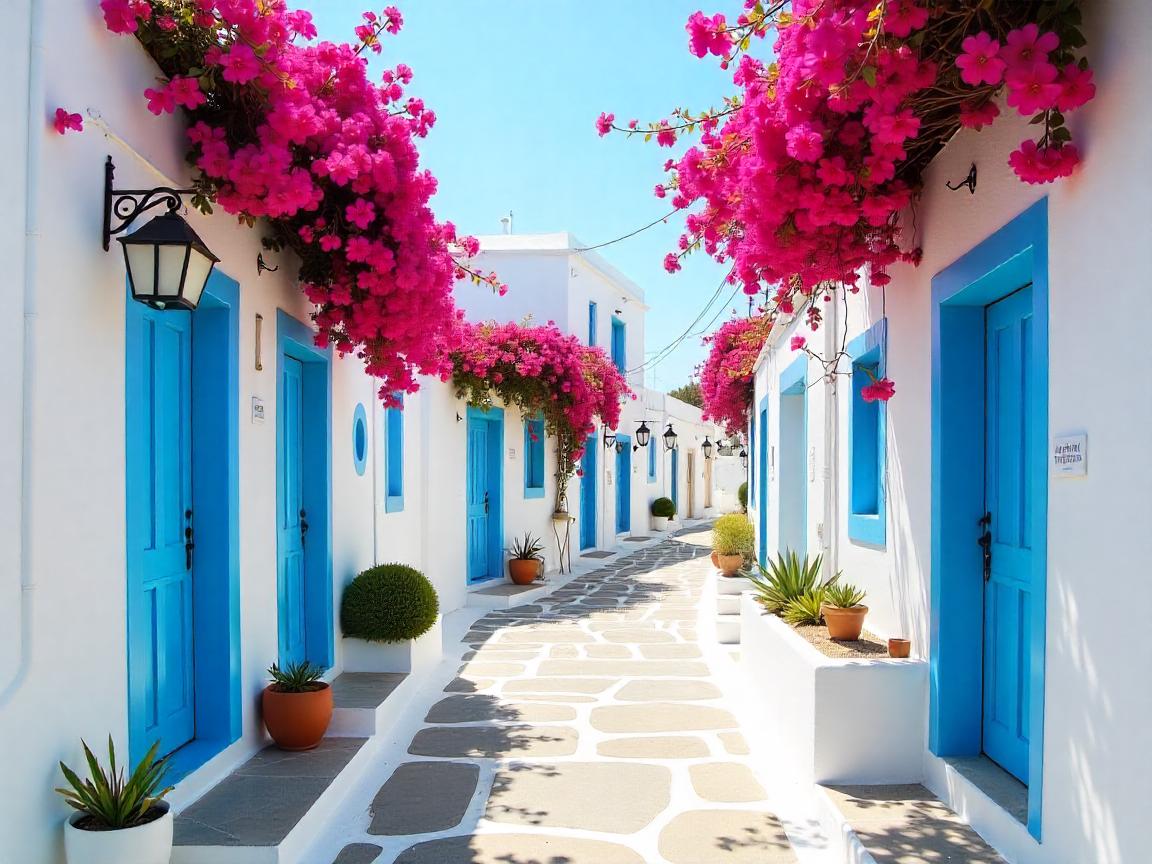≡-Now Greek Holiday Retreat Paros Outpaces Canary, Hvar, Seychelles, Mauritius, Azores in Becoming World’s Best Island Attracting Tourists from US, UK, Canada, Australia, Mexico, New Need To Know – Viral of Today
<> Viral of Today <>
Home » Greece » Greece Travel News » Now Greek Holiday Retreat Paros Outpaces Canary, Hvar, Seychelles, Mauritius, Azores in Becoming World’s Best Island Attracting Tourists from US, UK, Canada, Australia, Mexico, New Need To Know Sunday, July 13, 2025Once whispered about only among savvy Greek island-hoppers, Paros has rocketed into the global spotlight, outpacing renowned destinations like the Canary Islands, Hvar, the Seychelles, Maldives, Mauritius, and even the remote beauty of the Azores. This sun-drenched Cycladic retreat has claimed its place as the world’s best island, drawing curious travellers from every corner—from the US, UK, Canada, and Australia to Mexico, Puerto Rico, Germany, Spain, and even distant China.The reasons are as dazzling as Paros’s Aegean waters: a beguiling blend of traditional Greek charm, sophisticated boutique stays, and beaches that rival any tropical postcard. As tourism surges, Paros is no longer just a hidden gem—it’s the destination everyone suddenly needs to know. Whether you’re craving authentic tavernas, hiking trails under endless blue skies, or stylish harbours buzzing with nightlife, Paros promises a Greek holiday that feels both timeless and utterly of the moment.Tourism in 2025 is not merely about sun-drenched beaches or turquoise waters; it’s about global connections, unique experiences, and destinations that manage to appeal simultaneously to travelers from diverse regions like the United States, Mexico, Europe, and Canada. Let’s explore which islands are leading the charge — and why.Caribbean: A Firm Favorite for North Americans and EuropeansWhen North Americans dream of island escapes, the Caribbean invariably tops the list. The region’s proximity, year-round warm weather, and dazzling coastline keep it high on the travel agenda.Take The Bahamas, for instance. Recent tourism data shows over 11 million visitors flocked to its shores in 2024, with Americans constituting a large majority. Its short flights from Miami and major cruise stopovers make it especially appealing for U.S. tourists seeking quick getaways. The Bahamas is also actively investing in sustainable tourism, balancing environmental protection with high visitor numbers.Meanwhile, Aruba has carved out a niche as a sun-soaked escape with strong North American ties. Approximately 73% of its visitors hail from North America, drawn by the island’s reputation for constant sunshine and some of the Caribbean’s safest beaches. For European travelers, Aruba provides an intriguing contrast — familiar colonial architecture fused with Caribbean flair.In the broader region, islands like the Cayman Islands, Turks and Caicos, and US Virgin Islands continue to attract affluent travelers, many from the U.S. and Canada. These islands capitalize on direct flights, luxury accommodations, and a strong presence in the cruise market. Yet, as tourist numbers grow, concerns over environmental sustainability and local cultural preservation have become critical topics across the Caribbean.Europe’s Island Gems: History, Glamour, and SunshineFor Europeans — and increasingly North Americans and Mexicans — Mediterranean islands remain irresistible. Greece, in particular, has witnessed renewed interest from travelers worldwide.Paros, named the “World’s Best Island 2025” by Travel + Leisure readers, epitomizes the Cycladic allure: charming whitewashed villages, shimmering blue seas, and a vibrant culinary scene. The island has deftly balanced its increasing popularity with efforts to preserve its traditional character, an approach increasingly critical as overtourism strains local infrastructure elsewhere.Santorini, Mykonos, and Crete continue to be global icons. While Santorini’s blue-domed churches and caldera views are magnets for honeymooners, there’s a growing dialogue around managing visitor numbers to protect both the environment and local life.Beyond Greece, Spain’s Canary Islands — especially Tenerife — attract millions yearly, not only from Europe but increasingly from long-haul travelers seeking winter warmth. Tenerife hosted over 7 million tourists in 2024, many drawn to its diverse landscapes ranging from volcanic peaks to subtropical forests.Italian islands like Sicily and Sardinia, as well as Corsica in France and Madeira in Portugal, remain evergreen favorites. Their appeal lies in combining beach leisure with rich historical narratives and distinctive local cultures. Europeans flock to these islands, but they’re also gaining ground with North Americans looking for more immersive, culturally rich experiences.Indian Ocean and South Pacific: Luxury and ExclusivityWhile the Caribbean and Mediterranean dominate numbers, the Indian Ocean and South Pacific islands maintain their mystique as exclusive hideaways.The Maldives, Seychelles, and Mauritius have long been synonymous with luxury travel. Once considered honeymoon-only destinations, these islands are diversifying, offering wellness retreats, adventure sports, and sustainable tourism initiatives. Condé Nast Traveler continues to rank them among the world’s top islands for their pristine beaches and luxury resorts.Meanwhile, Fiji and Bora Bora hold strong appeal, particularly for North American travelers willing to fly farther for secluded overwater bungalows and coral reef experiences. Airlines are increasingly offering package deals that make South Pacific travel slightly more accessible, though these remain premium destinations.Islands off the Beaten Path: A Rising TrendModern travelers are often seeking destinations that feel undiscovered. Here, lesser-known islands are emerging into the spotlight.The Azores, an archipelago in the mid-Atlantic belonging to Portugal, is drawing eco-conscious travelers from Europe, Canada, and the U.S. Its volcanic landscapes, whale-watching opportunities, and mild climate are increasingly promoted as a sustainable alternative to more crowded destinations.Hvar, in Croatia, has shifted from a well-kept European secret to a celebrity hotspot. Once popular primarily among European vacationers, the island now receives American and Canadian travelers lured by its medieval towns and sparkling Adriatic waters.In Asia, Indonesia’s Komodo Archipelago is enticing a global audience intrigued by dramatic landscapes and wildlife — particularly the famed Komodo dragons. While still less visited than Bali, Komodo is carving out a reputation among adventurous tourists from North America and Europe alike.North America’s Islands: Homegrown FavoritesNot every island escape requires crossing an ocean. Within the United States, places like Hilton Head and Kiawah Island in South Carolina remain beloved retreats for American and Canadian tourists alike. These islands offer the charm of coastal communities, world-class golf courses, and protected natural reserves.Then there’s Hawai’i, which consistently ranks as one of the top island destinations for American travelers. Its volcanic landscapes, vibrant Polynesian culture, and commitment to eco-tourism keep it firmly on the bucket lists of millions.From Mexico, Isla Holbox has become a rising star. Located off the Yucatán Peninsula, it offers pristine beaches, bioluminescent waters, and a laid-back atmosphere that resonates with Mexican tourists and a growing influx of Canadians and Americans. Holbox’s sustainable tourism efforts have also earned it praise among environmentally conscious travelers.Paros, Greece: How a Cycladic Gem is Navigating a Tourism BoomTucked into the heart of the Aegean Sea, Paros has long been a darling of Greek island hoppers—a place where whitewashed villages meet sapphire seas. But behind its postcard-perfect facade, Paros is grappling with a new reality: booming tourism numbers, big-money investments, and the challenges of protecting its fragile environment. As Greece sails through record tourism highs, Paros has found itself squarely in the spotlight, trying to balance prosperity with sustainability.Tourist Arrivals Soar as Paros Rides Greece’s Record-Breaking YearGreece’s tourism machine roared back in 2024, with the country welcoming 40.7 million visitors—a staggering 12.8% rise over the previous year. This record-breaking figure reflects how pent-up travel demand and Greece’s enduring allure have merged into a powerful force. The South Aegean region, where Paros sits alongside star destinations like Mykonos and Santorini, stood out as the nation’s top earner, generating €5.687 billion in tourism receipts.While there’s no official single figure published for total arrivals exclusively to Paros, the signs are clear that the island has been swept up in this wave. Hotel bookings, ferry passenger numbers, and tourism revenues all point in one direction: up. Paros’s permanent population hovers around 14,500 residents, yet in peak summer, the island pulses with tens of thousands of visitors, transforming its tranquil villages into bustling tourism hubs.The New Face of Paros Tourism: High-Spending Visitors and Year-Round AppealA closer look at who’s coming to Paros reveals a tourism market that’s shifting from quantity to quality. American visitors surged by 15.4% in 2024, while UK travelers continued to expand their presence, especially during the “shoulder seasons” of May, June, and September. That’s good news for an island keen to extend its season beyond the crowded summer months.Tourists to Paros aren’t just coming in greater numbers—they’re spending more. Data from Visa and Ipsos shows American travelers spend an average of €3,040 per person on Greek vacations, while UK tourists average around €1,900. These figures help explain why Paros is pivoting toward attracting high-income visitors. The island’s accommodation revenue alone climbed to €85.34 million in 2024—a 6.3% increase from 2023—while catering revenues held steady at €89.2 million.The appeal is broad: couples make up the largest group of visitors (about 52.6%), while families and groups account for the rest. Yet no matter the demographic, Paros is emerging as a destination for travelers seeking an authentic Greek experience layered with a touch of Cycladic luxury.Cruise Industry’s Ripple EffectAlthough Paros is not a major cruise hub like Mykonos or Santorini, it still benefits indirectly from Greece’s surging cruise market. In 2024, Greece saw 5,308 cruise ship arrivals carrying nearly 5 million passengers—a 43.8% jump compared to the previous year. Many cruise visitors book day trips to nearby islands, including Paros, bringing a fresh wave of short-term tourism spending.These day-trippers inject money into local businesses, from tavernas in Naoussa to artisan shops in Parikia. However, they also add strain to infrastructure and contribute to concerns about overtourism, a challenge Paros shares with much of the Cyclades.Hotel Stays and the Accommodation BoomParos’s accommodation scene has evolved dramatically in recent years. Once dominated by modest family-run guesthouses, the island now features boutique hotels, luxury villas, and even exclusive resorts aiming for the high-end market. The result is a significant jump in both quality and visitor numbers.Industry reports indicate hotel demand per property rose 5.7% in 2024 compared to the previous year. This aligns with Paros’s growing reputation as a premium destination capable of attracting visitors who value upscale experiences over mass tourism.However, with success comes challenges. The Cyclades, including Paros, have witnessed a flurry of construction activity—more than 1,300 building permits were issued on Paros between 2018 and 2023, surpassing even Santorini or Mykonos during the same period. While new infrastructure helps accommodate rising demand, locals and experts worry about environmental degradation and the potential erosion of the island’s traditional character.Visitors Spending Big but Locals Sound CautionParos’s economic data tells a story of prosperity. The combined revenue from accommodation and catering businesses surpassed €174 million in 2024. The island’s tourism footprint fuels jobs, supports local businesses, and sustains ferry operators and tour guides.Yet even as money flows in, concerns are rising about sustainability. The island faces challenges familiar across the Cyclades: water scarcity, waste management, and a housing market distorted by short-term rentals. Local residents increasingly voice fears that Paros could follow the trajectory of more overtouristed islands, where infrastructure buckles under seasonal surges and natural resources dwindle.Investing for a Sustainable FutureIn response, Paros is betting on infrastructure improvements and strategic planning to balance tourism growth with sustainability. A €34 million project is underway to expand the island’s airport. Slated for completion by 2026, the renovation will include a modern terminal, larger gate lounges, and improved runway facilities. Officials hope these upgrades will make Paros more accessible for international travelers while dispersing arrivals more smoothly.Moreover, local authorities are working to encourage visitors during the off-peak months. Marketing campaigns highlight Paros’s lesser-known charms in spring and autumn—from serene hiking trails and gastronomic festivals to calmer beaches free of high-season crowds.Paros at a CrossroadsAs Greece celebrates record-breaking tourist numbers, Paros stands at a pivotal moment. The island is navigating the tension between welcoming high-spending tourists and preserving its identity as a laid-back Cycladic haven.On the one hand, there’s optimism. New investments, a global spotlight, and rising visitor spending all promise economic security. Yet, on the other hand, locals fear that unbridled growth could chip away at the very qualities that make Paros special—its authenticity, natural landscapes, and close-knit community feel.From an economic standpoint, the shift toward “quality over quantity” tourism appears both wise and necessary. If Paros can attract fewer but higher-spending tourists while extending its tourism season, it could sustain growth without overwhelming its environment or local society.The Cycladic Island That Has It AllThe first thing you notice about Paros isn’t a single monument or famous beach—it’s a feeling. The soft rustle of wind across whitewashed alleys. The hush of turquoise waves kissing golden sands. The swirl of life in lively squares where grandmothers chat over coffee while chic visitors snap photos of vibrant bougainvillea. Paros, somehow, strikes the perfect balance between cosmopolitan cool and authentic Greek charm—a rare feat in the ever-popular Cyclades.Less showy than Mykonos, less overrun than Santorini, Paros is the sort of island where you arrive planning a brief stay and find yourself canceling your next leg, seduced by its understated beauty and mellow energy. Here’s why you might want to follow suit.The Lay of the LandLocated smack in the heart of the Cyclades, Paros has long been a crossroads. Its ancient marble quarries once supplied stone for masterpieces like the Venus de Milo. Today, its role is less sculptural and more cultural—a meeting point for island hoppers, artists, foodies, and seekers of low-key luxury.The island’s geography has range: soft sandy beaches on one side, rugged coastlines on the other. Inland, gentle hills are dotted with olive groves and vineyards. Two main towns anchor the island: Parikia, the lively port town, and Naoussa, a picturesque fishing village turned stylish harbor with a buzzy nightlife.Yet part of Paros’s magic lies in its villages. Lefkes, once the island’s capital, is a labyrinth of narrow lanes and blooming geraniums, set high enough for sweeping sea views. Marpissa and Kostos, meanwhile, feel blissfully stuck in time.Where to StayParos’s accommodation scene has undergone a quiet revolution in recent years. Forget dated pensions with floral bedspreads—though those still exist for budget travelers. The island now boasts sleek boutique hotels, lovingly restored villas, and stylish guesthouses that wouldn’t look out of place in a design magazine.Parilio, part of Design Hotels, epitomizes Paros’s new aesthetic: minimalist Cycladic architecture, pale stone surfaces, and interiors that play with light and shadow. Its pool, ringed by raw stone monoliths, is a modern Greek sanctuary.In Naoussa, Cove Paros offers luxury suites just steps from the sea, with a breezy, neutral palette and a restaurant helmed by acclaimed chefs. For a more local vibe, boutique options like Argonauta Hotel in Parikia combine contemporary comforts with heartfelt Greek hospitality.Where to Eat & DrinkFood in Paros is having a moment. Chefs are leaning into farm-to-table concepts and reviving forgotten Cycladic recipes. Yet the soul of Paros cuisine still lives in its traditional tavernas, where tables groan under platters of grilled octopus, marinated anchovies, and fava puree drizzled with bright green olive oil.Start in Naoussa’s harbor, where old fishermen’s storage houses now host elegant seafood restaurants and cocktail bars. At Soso, a tiny spot tucked into an alley, the chef whips up creative meze with surprising finesse—think beetroot salad with pistachio crumble or calamari stuffed with sundried tomatoes.In Parikia, Levantis offers upscale dining beneath a romantic vine canopy. The menu dances between Greek classics and modern riffs, using island produce wherever possible. For a low-key meal, try Taverna Mouragio, where the grilled fish is as fresh as the gossip among locals.Don’t leave Paros without tasting local specialties: chickpea balls (revithokeftedes), Parian cheeses like myzithra, and wines from the island’s growing roster of small producers. Wineries like Moraitis near Naoussa welcome visitors for tastings of their crisp whites and robust reds.Beaches for Every MoodParos’s beaches deserve their own love letter. Unlike some Cycladic islands where rocks drop straight into the sea, Paros offers gentle sandy arcs perfect for swimming and sunbathing.Kolymbithres is the showstopper—a series of smooth granite formations creating private coves with shallow aquamarine water. It’s photogenic, but can get busy in peak season.Prefer solitude? Head to Faragas, a small bay with golden sand and a laid-back vibe. Or seek out Kalogeros Beach, famous for its natural clay cliffs—locals swear the clay works wonders as a free spa treatment.Windsurfers flock to Golden Beach, whose strong breezes make it a hotspot for international competitions. Even if you’re not riding the waves, it’s fun to watch the colorful sails dart across the horizon.Culture & Things to DoBeyond beaches, Paros brims with cultural gems. In Parikia, visit the Panagia Ekatontapiliani, one of the oldest churches in Greece, dating back to the 4th century. Its cool marble interiors and ornate icons offer a serene respite from the sun.Art lovers will find galleries scattered across Naoussa and Parikia showcasing everything from contemporary Greek painting to marble sculpture. In the hill village of Lefkes, tiny artisan shops sell handmade ceramics and textiles.For active travelers, Paros offers a network of old Byzantine footpaths perfect for hiking. A favorite route runs from Lefkes to Prodromos, meandering through olive groves and offering breathtaking sea vistas at nearly every turn.Adventurers can sail to Antiparos, Paros’s smaller sibling. Just a 10-minute ferry ride away, Antiparos charms visitors with pristine beaches and the famous stalactite cave that plunges over 100 meters underground. Hollywood A-listers have taken a shine to Antiparos—Tom Hanks has a villa there—but it retains an easygoing vibe.Shopping the Parian WayShopping on Paros balances tourist-friendly souvenirs with genuine artisanal finds. In Naoussa, browse chic boutiques like Anthologist for linen dresses and statement jewelry. Parikia offers beautiful handmade leather sandals and ceramics. For something uniquely local, pick up Parian marble pieces—small sculptures, candle holders, or simple bowls—crafted from the same stone that built ancient temples.A Sustainable FutureWith tourism booming—Paros’s accommodation revenues surpassed €85 million in 2024—the island is working hard to avoid the pitfalls of overtourism. A €34 million upgrade to its airport is in progress, aiming to disperse arrivals more smoothly and extend tourism into the shoulder seasons.Locals and officials alike are determined to preserve the island’s character. New development is under stricter scrutiny, and initiatives encourage sustainable practices among hotels and restaurants.When to GoHigh summer (July and August) brings hot days, crowded beaches, and buzzing nightlife. For a more relaxed vibe, visit in May, June, or September. The sea is still warm, prices dip slightly, and the island feels like its authentic self.In Paros, life unfolds at a pace dictated by sun and sea. It’s a place where centuries-old traditions thrive beside stylish hotels, and where each sunset promises another reason to stay just a little longer. Whether you’re chasing hidden beaches, artisanal shops, or your own Cycladic daydream, Paros is the Greek island that quietly, confidently, has it all.A Greek Island’s Modern StoryUltimately, Paros offers a fascinating microcosm of modern Mediterranean tourism. It’s a place where visitors wander sunlit alleys in Naoussa, sip ouzo beside gentle waves, and marvel at centuries-old marble quarries. Yet it’s also a destination caught between opportunity and caution.Tourists arriving in Paros today are part of a bigger story—a story about how beloved destinations adapt to a world where travelers are more numerous, more global, and more demanding than ever before. As Paros looks to the future, its choices will determine whether it remains simply another crowded hotspot—or continues shining as a Cycladic gem where beauty and sustainability coexist.Shared Motivations, Regional PreferencesWhile each region has its distinct flavor, there are clear threads uniting why these islands appeal so broadly:Accessibility is key. Whether it’s a two-hour flight from Miami or direct connections from major European hubs, ease of travel often dictates destination popularity.Natural beauty remains a primary draw, but travelers increasingly demand unique experiences — local culture, history, and wildlife — rather than just sun and sand.Safety and infrastructure weigh heavily in decision-making, particularly for American and Canadian tourists seeking reliable services abroad.Sustainability is shaping decisions. From Greece to the Caribbean, travelers are becoming more conscious of overtourism’s impacts and seeking destinations that prioritize environmental stewardship.The Road Ahead: Islands Navigating Tourism’s FutureIsland destinations face a delicate balancing act in 2025. Many continue to break visitor records, yet overtourism and environmental concerns loom large. Some, like Santorini and parts of the Caribbean, are implementing stricter visitor limits or new sustainability policies to protect fragile ecosystems and local life.Meanwhile, islands once considered remote are emerging as viable alternatives, driven by travelers’ hunger for authenticity and fewer crowds. As connectivity improves and global tourism diversifies, expect new islands to enter the spotlight — each offering its own unique blend of nature, culture, and the promise of escape.Whether you’re dreaming of Mediterranean sunsets, Caribbean coral reefs, or South Pacific lagoons, the world’s islands remain the stage upon which travelers from the U.S., Mexico, Europe, and Canada play out their visions of paradise. The challenge, and opportunity, lies in ensuring these slices of paradise remain sustainable and vibrant for generations to come.Tags: Australia, azores, Best of Greece, Canada’\, Canary, china, germany, Greece tourism, Hvar, maldives, mauritius, mexico, Paros, puerto rico, Seychelles, spain, UK, US, World’s Best Island
This information will surprise you!
See also
- Read until the end to discover everything.
- Important information you need to know.
- Interesting facts and helpful tips.
Conclusion
Did you enjoy the news? Keep following us daily!













